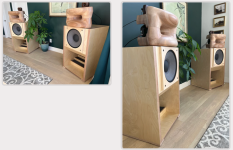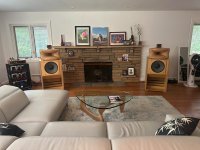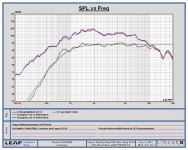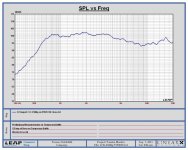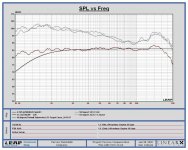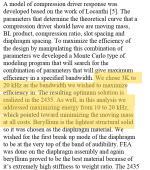Would one be like this one?
- CONSTANT DIRECTIVITY ON A HORIZONTAL PLANE & HYPERBOLIC ON A VERTICAL PLANE
a 60x40 deg horn fits that description normally.narrow
For HT a 90x60 deg is often advised fx.
You mean the Narrowing directivity? well Troys horns does the same more or less. But the throat will be matched to the driver.But I wonder if he notices the frequency "climbing"
He is right, due to lobing and ctc distance in general.Weltersys's solution for that is scratch Gary's wooden U-mount and Pierre's metal tripods
It is just a choice of compromises. And a supertweeter on a axis-symmetrical" horn with the required high xo will always be a compromise. Some find it worth it, many do not because of the unavoidable acoustical issues with integraing a tweeter at fx 9khz, with a ctc distance of 30-50 cms.But by doing so, might not a ribbon or AMT tweeter be successfully utilized if placed above the horns?
Every design choice is is a compromise, that has positive and negative effects. You just have to choose which is to your preference.
The other side to this coin is that we have reduced sensitivity to errors we may make in the lobing/power balance, both below and above the critical ~3kHz region. This may help to explain that so many speakers (perhaps not all) can do well this way.the unavoidable acoustical issues with integraing a tweeter at fx 9khz, with a ctc distance of 30-50 cms.
Be that as it may, some feel that using a compression tweeter to the upper limit is not all that difficult by comparison.. although there is a whole topic of discussion behind that.
No, I mean what Pierre described: Commenting briefly on the TH4001 horn, I appreciate how it positions the drivers closer together than the round AH425, and as a result, how musical instruments sound better integrated, e.g. notes don't appear to climb up or down in space according to their frequency.You mean the Narrowing directivity? well Troys horns does the same more or less. But the throat will be matched to the driver.
Yes, minimizing the center-to-center driver distance might satisfactorily eliminate any otherwise noticeable lack of musical instrument integration. But it would appear that the ES450 has a much more convenient form factor to achieve this. Also, I strongly dislike the look of white horns and don't know if an auto body shop is the right place to get 425 horns painted (Altec gray, black? But what kind of safe paint base?), since neither Troy nor I want to do it. ES450 should be available in dark walnut stain.He is right, due to lobing and ctc distance in general.
And the narrowing directivity is at about the same rate in both horns.
Troy Crowe usually offers the ES450 as a B&C DCM50/Fostex T925A + Low Diffraction Lens combo, like in the system I heard late last month.The other side to this coin is that we have reduced sensitivity to errors we may make in the lobing/power balance, both below and above the critical ~3kHz region. This may help to explain that so many speakers (perhaps not all) can do well this way.
Be that as it may, some feel that using a compression tweeter to the upper limit is not all that difficult by comparison.. although there is a whole topic of discussion behind that.
https://josephcrowe.com/blogs/news/es-450-biradial-no-2143?_pos=1&_sid=d6c81ec37&_ss=r
https://josephcrowe.com/blogs/news/fostex-t900a-with-horn-lens-no-2258?_pos=3&_sid=d6c81ec37&_ss=r
The last two-way system I heard was like ten years ago; pair of Voltis at Pete Grzybowski's house. The acoustics, placement and source material were different, but if I had to choose I'd go with the Voltis. For a two-way system I could be flexible with the driver to avoid need of an adapter; either the Radian745NeoBe or
https://www.usspeaker.com/radian 760neoBepb-1.htm
https://www.usspeaker.com/radian 950Bepb-1.htm
https://www.usspeaker.com/radian 951Bepb-1.htm
Need help deciding.
Attachments
Go with the parts you have. I have a feeling you'll be fretting after the fact regardless of which you choose: At least this way you won't be throwing good money after bad.
I know that all sound like good advice. I have a pair of the AH425 horns but though they and the ES450s have similar directivity patterns there are likely some substantially audible differences-and I've given up seeking invitations to hear the AH425s.
I am not nor have time to become a competent DIYer anywhere near soon enough, so it would be unwise to have Troy Crowe spend who knows how long it would take designing a contouring filter for a 425 horn/Radian 745Be combo. Furthermore, Pierre and g3dahl were the only ones I know who did this. Gary ended up rejecting the "hardness". After numerous attempts Pierre's filter worked a while. But he permanently swapped the Radians 745 Bes into TH4001 horns, and sold the 425s, which as I've noticed quite a few have.
AFAIK, Gary has long and continues enjoying the 425 horns with Yamaha JA6681B drivers, albeit without response > 10kHz, due to problems integrating his Raal Lazy ribbon tweeters; see attached. However, I recall Weltersys recently noting those tweeter issues might be due to lack of absorbent material applied to rear of 425 horns (?). I also have a pair of JA6681B drivers tested by Troy, but won't risk getting those pricey Raal ribbons for want of a proven system, and no other practical HF range solution looks doable.
I thought of going with the tweeterless Yamaha/425 combo atop my clones of Gary's midwoofers if I had at least once heard the 425s. But never even heard the Quad 57 ESLs, which I think Lynn Olson once likened them to.
Then is the ES450 horn with B&C DCM50 8 ohm/Fostex T96A + Low Diffraction Lens. At least I heard that combo. I had two hours hearing it play my files on Glen's system, though I was a bit tired and anxious due to almost failing to fix a software driver glitch on my laptop which could have made the whole listening session impossible. It all had a relaxed and neutral and generally agreeable sound, but I'm wondering if the 16 ohm version would have worked better for Glen's Triode Labs 45 tube amps, as the 16 ohm version is commonly used throughout most of Troy's builds. https://josephcrowe.com/pages/project-matrix?_pos=8&_sid=4c8e4bf2a&_ss=r And one of my amps will likely insist on it.
https://www.stereophile.com/content/first-watt-j2-power-amplifier-measurements
I thought about using the Radian 745Be in the ES450 horns, but not if a throat adapter was needed, assuming Troy's contouring filter could make that two-way combo way sound better than what I heard from the ES450 last month.
Otherwise, I'm inclined towards deciding between the ES450/DCM50 16 ohm/Fostex T925A and AH425/Yamaha. Either one should give me focused direct sound and very good imaging.
Beyond that, how to decide? This may sound trivial but unless an auto body shop is the best place to get the 425 horns painted then it has to be the ES450. I usually keep subdued lighting in my room and can't have big round white things staring at me.
What of the Radians Bes? Later after using the system and after my room is fully evaluated I'll be seeking help deciding on constant directivity horn options to build a two-way system for realizing the best spacious sound which I also want to experience.
I am not nor have time to become a competent DIYer anywhere near soon enough, so it would be unwise to have Troy Crowe spend who knows how long it would take designing a contouring filter for a 425 horn/Radian 745Be combo. Furthermore, Pierre and g3dahl were the only ones I know who did this. Gary ended up rejecting the "hardness". After numerous attempts Pierre's filter worked a while. But he permanently swapped the Radians 745 Bes into TH4001 horns, and sold the 425s, which as I've noticed quite a few have.
AFAIK, Gary has long and continues enjoying the 425 horns with Yamaha JA6681B drivers, albeit without response > 10kHz, due to problems integrating his Raal Lazy ribbon tweeters; see attached. However, I recall Weltersys recently noting those tweeter issues might be due to lack of absorbent material applied to rear of 425 horns (?). I also have a pair of JA6681B drivers tested by Troy, but won't risk getting those pricey Raal ribbons for want of a proven system, and no other practical HF range solution looks doable.
I thought of going with the tweeterless Yamaha/425 combo atop my clones of Gary's midwoofers if I had at least once heard the 425s. But never even heard the Quad 57 ESLs, which I think Lynn Olson once likened them to.
Then is the ES450 horn with B&C DCM50 8 ohm/Fostex T96A + Low Diffraction Lens. At least I heard that combo. I had two hours hearing it play my files on Glen's system, though I was a bit tired and anxious due to almost failing to fix a software driver glitch on my laptop which could have made the whole listening session impossible. It all had a relaxed and neutral and generally agreeable sound, but I'm wondering if the 16 ohm version would have worked better for Glen's Triode Labs 45 tube amps, as the 16 ohm version is commonly used throughout most of Troy's builds. https://josephcrowe.com/pages/project-matrix?_pos=8&_sid=4c8e4bf2a&_ss=r And one of my amps will likely insist on it.
https://www.stereophile.com/content/first-watt-j2-power-amplifier-measurements
I thought about using the Radian 745Be in the ES450 horns, but not if a throat adapter was needed, assuming Troy's contouring filter could make that two-way combo way sound better than what I heard from the ES450 last month.
Otherwise, I'm inclined towards deciding between the ES450/DCM50 16 ohm/Fostex T925A and AH425/Yamaha. Either one should give me focused direct sound and very good imaging.
Beyond that, how to decide? This may sound trivial but unless an auto body shop is the best place to get the 425 horns painted then it has to be the ES450. I usually keep subdued lighting in my room and can't have big round white things staring at me.
What of the Radians Bes? Later after using the system and after my room is fully evaluated I'll be seeking help deciding on constant directivity horn options to build a two-way system for realizing the best spacious sound which I also want to experience.
Attachments
He makes a 1,4" version ES450 already.I thought about using the Radian 745Be in the ES450 horns, but not if a throat adapter was needed,
A good car painter will have no issues doing it.This may sound trivial but unless an auto body shop is the best place to get the 425 horns painted then it has to be the ES450. I usually keep subdued lighting in my room and can't have big round white things staring at me.
I am sure you could find 100 decent, qualified hvlp gun painters in NY without issues.
am not nor have time to become a competent DIYer anywhere near soon enough, so it would be unwise to have Troy Crowe spend who knows how long it would take designing a contouring filter for a 425 horn/Radian 745Be combo.
Not for nothing but It's not a big deal and it shouldn't take a lot of time. As long as he has a good measurement set and crossover software like LEAP.
Problem with Be is the last octave roll off. May not get enough HF energy in the room depending on the roll off, woofer sensitivity and directivity.
Beyond that, how to decide? This may sound trivial but unless an auto body shop is the best place to get the 425 horns painted then it has to be the ES450. I usually keep subdued lighting in my room and can't have big round white things staring at me.
Like any DIY build you won't know for sure until you make the build, listen and make changes if you feel they are necessary. Paint them a dark color that blends with the colors in the room. I just go black non reflective looks smaller doesn't call attention.
If they wink you have a problem!
Rob 🙂
https://culturehustle.com/products/...orld-s-mattest-flattest-blackest-art-materialusually keep subdued lighting in my room and can't have big round white things staring at me.
Hi @Robh3606 ,
Kindest regards,
M
Is this the case or does the roll-off appear steeper because of higher mid-range sensitivity? Would you, by a chance have a comparison with Ti SL diaphragm under the same input signal?Problem with Be is the last octave roll off.
Kindest regards,
M
Yes,.Is this the case or does the roll-off appear steeper because of higher mid-range sensitivity?
There is no "secondary" resonances that extends/flattens the top end response.
Also due to inductance.
Would you, by a chance have a comparison with Ti SL diaphragm under the same input signal?
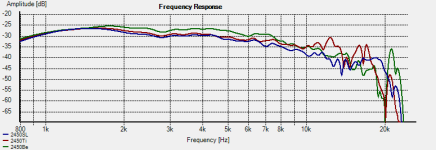
Look here:
https://www.audioheritage.org/vbulletin/showthread.php?31657-Truextent-diaphragms-measurements
Hi @Robh3606 ,
Is this the case or does the roll-off appear steeper because of higher mid-range sensitivity? Would you, by a chance have a comparison with Ti SL diaphragm under the same input signal?
Kindest regards,
M
Hello
I ended up with a pair of 2216's that were power tested and a pair of 435 Be's from the JBL lab. I wanted to do a passive 2 way based on the M2 design. When I looked at matching the sensitivity it was an issue WRT a comp curve and the HF roll off. I was lucky and sourced a pair or 476 Mg's which have a rising HF in comparison. Then I swapped my aguaplas coated 2435's in my active set-up for 2453SL's a year later.
It's not a 1 to 1 but it gives you a trend. The SL's are cleaner than the embossed uncoated Ti's. Just look at the plane wave tube measurements on Lansing Heritage for various CD's.
These are all measured on the same wave guide a PTH 1010. The Be roll off can be an issue if you can't bring down the midrange below a certain SPL level doing it passive. Active like the 2435's used in Vertec it's a moot point. It's all about how you plan on using the drivers.
Rob 🙂
Attachments
The 2435 was designed with the HF rolloff intentionally, looking to achieve "pistonic" action to 15khz and trying to avoid diaphragm and surround resonances.I ended up with a pair of 2216's that were power tested and a pair of 435 Be's from the JBL lab. I wanted to do a passive 2 way based on the M2 design. When I looked at matching the sensitivity it was an issue WRT a comp curve and the HF roll off.
These are all measured on the same wave guide a PTH 1010. The Be roll off can be an issue if you can't bring down the midrange below a certain SPL level doing it passive. Active like the 2435's used in Vertec it's a moot point. It's all about how you plan on using the drivers.
There is also the different phase plug, and smooth half roll surround.
Your 476's also incorporates a copper shorting sleeve in the motor structure to keep inductance flat so there is no rolloff due to that, which will help with the rising response.
Whereas the TAD's use the half roll surround resonance to extend the 'flat" response.
Same does the TI/SL drivers with the diaphragm resonnaces, just the SL is damped.
And that is the idea of the diamond surround and Coherent wave phasing plug too.
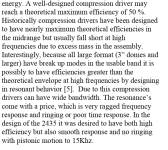
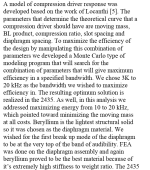
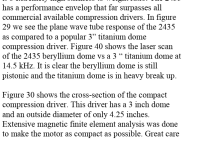
Ref:
High Frequency Components for High Output Articulated Line Arrays , Doug Button. - Audio Engineering Society Convention Paper Presented at the 113th Convention 2002 October 5–8
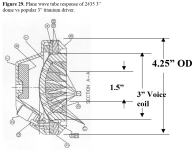
Last edited:
The 2435 was designed with the HF rolloff intentionally, looking to achieve "pistonic" action to 15khz and trying to avoid diaphragm and surround resonances.
Hello Arez
Not sure about that. It contradicts what's in the paper I highlighted the section. Pistonic in the last octave is not necessarily rolled off. You also have to remember intended use in the Vertec's. They were EQ'd +12 Db @ 16K then a low-pass at 22K. Yes use a mylar surround with ferro fluid.
Rob 🙂
Attachments
Last edited:
The first picture explains it very clear actually. actually Also fits Buttons rationale when it comes to hf driver design.Not sure about that. It contradicts what's in the paper I highlighted the section. Pistonic in the last octave is not necessarily rolled off.
There is no way to avoid resonances in a 3-4" dome at 15khz, wavelength is ca 22mm, the wavelengths are too short for such a large surface and you get bending modes/breakup in the diaphragm even when using Beryllium. As far as i'm aware there never was made a CVD diamond diaphragm for a compression driver, also would be heavy. Mitsubishi/Diatone also had a interesting boron/ Carbon material from 2016 that looked promising.
This is the diaphragm in question at 14,5khz, it's already not pistonic anymore per se.
Just as with a woofer/mid whatever going too high.
Yes it is as there is not a single large format compression driver that does not exhibit bending modes/breakup and resonances when used out to 20k, the question is more how many modes are acceptable, and how well the diaphragm is damped, how the surround acts in damping resonances etc.Pistonic in the last octave is not necessarily rolled off.
Also a dip might be easier to live with then a peak caused by the same.
Attachments
-
JBL&Murray_1979_Diamond_Susp.pdf582.8 KB · Views: 17
-
Beryllium_Live-Sound-International_PrintQuality (1) g.pdf2.8 MB · Views: 26
-
extended-range-beryllium-dome-diaphragm-assembly-for.pdf1.3 MB · Views: 24
-
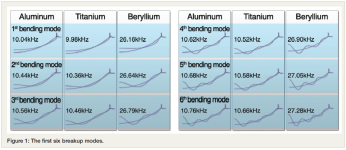 bending.PNG284.4 KB · Views: 23
bending.PNG284.4 KB · Views: 23 -
doug_button_258_final_rev_c_original.pdf2.9 MB · Views: 25
-
1209.pdf245.8 KB · Views: 21
Last edited:
Can that question be answered this way: Say that I send one of these Radian Bes to Troy Crowe to mate with his ES450 horn (once Troy assures me that no adapter's needed) https://www.usspeaker.com/radian 745neoBepb-1.htm or https://www.usspeaker.com/radian 760neoBepb-1.htmthe question is more how many modes are acceptable, and how well the diaphragm is damped, how the surround acts in damping resonances etc.
Before Troy either begins or starts building and measuring the filter to extend the driver's HF response (to ~ 15kHz ?), would he be doing routine burst decay, spectral decay (and then or later harmonic and IM distortion) tests to know where to roll off the filter to thereby avoid resonances for maintaining the diaphragm's pistonic motion?
If Troy can achieve this rather easily given this horn's polar chart
https://cdn.shopify.com/s/files/1/0...ot_2023-10-14_170306_480x480.png?v=1697317415 would there be anything to be gained, however subjectively audible, from adding a tweeter, such as
https://croweaudio.blogspot.com/2020/10/fostex-t925a.html
https://www.madisoundspeakerstore.com/amt/
https://www.madisoundspeakerstore.c...l-140-15d-ribbon-tweeter-with-amorphous-core/
Do not worry about it.Before Troy either begins or starts building and measuring the filter to extend the driver's HF response (to ~ 15kHz ?), would he be doing routine burst decay, spectral decay (and then or later harmonic and IM distortion) tests to know where to roll off the filter to thereby avoid resonances for maintaining the diaphragm's pistonic motion?
There is nothing you want to do to reduce the drivers output in band, the challenge is the fairly large HF dropoff that's there already.
Only a concern if you want to implement a tweeter.
Either the HF is dropping past the mass break point - fHM , or the response is "modulated" by resonances / secondary output to extend the useful "flat response", there is no way completely around the laws of physics. That is disregarding any horn, as measured in a PWT.
As you can see in any compression driver the low end has output climbing until the mass breakpoint, before it falls off just look at the pic. below.
The added document shows most of this quite well, including the previous posts.
Note it's a 1", 1,75" coil 2425 Ti in the pic.
If you want to experiment with taming the top end of it, kill the large breakup modes after 20khz and measure/evaluate.
You can read this link to understand why, with graphics.
https://purifi-audio.com/blog/app-notes-2/low-distortion-filter-for-ptt6-5x04-naa-11
Attachments
Last edited:
LEAP is apparently gone.Not for nothing but It's not a big deal and it shouldn't take a lot of time. As long as he has a good measurement set and crossover software like LEAP. Problem with Be is the last octave roll off. May not get enough HF energy in the room depending on the roll off, woofer sensitivity and directivity.
https://www.physical-lab.com/products/linearx/cae-software/leap But Troy Crowe obviously had something to measure my midwoofers. https://josephcrowe.com/blogs/news/altec-416-8b-in-100l-sealed
Presumably, I won't be running them much above 80db at ~ 70Hz above my three Rythmik F12 subs (using this converter https://www.merging.com/products/interfaces/hapi ). I haven't yet posted a sufficiently detailed account of my room acoustics, but they and the size are not unlike most second floor co-op apartment living rooms with a total interior of 1100 sq ft. However, assuming this is ideal, I will strive to keep my room as empty as possible before and after room analysis and treatment.
If you want to experiment with taming the top end of it, kill the large breakup modes after 20khz and measure/evaluate.
Last edited:
Limmer Horns? Like 250nCan you give examples of commercially available narrow constant directivity horns? Would one be like this one? https://usspeaker.com/ciare pr614-1.htm
https://www.limmerhorns.de/250-w-m-n/
I use the 033 for a BMS 2"/1" Coax. But there are also bigger ones.
- Home
- Loudspeakers
- Multi-Way
- 1.4" or 2" throat large constant directivity horns you can actually buy!
